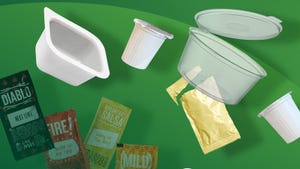By Design: Part design 106 - Corner radiuses
In this bimonthly column, Glenn Beall of Glenn Beall Plastics Ltd. (Libertyville, IL) shares his special perspective on issues important to design engineers and the molding industry.
November 28, 1999
In this bimonthly column, Glenn Beall of Glenn Beall Plastics Ltd. (Libertyville, IL) shares his special perspective on issues important to design engineers and the molding industry.
A properly designed injection molded part is characterized by having uniform wall thickness, draft angles, and rounded corners. These rounded corners have two primary functions. They improve the flow of the melt around a corner, allowing the cavity to be filled at lower injection pressures and resulting in less molded-in stress throughout the part. Corner radiuses also make molded parts stronger by distributing any stress on the corner over a broader area on the part. In other words, there is more plastic material to absorb the load.
The injection molding process is unforgiving of sharp inside corners on 3-D parts. Figure 1 shows a cross-section of a portion of a mold for a 3-D box-shaped part. The left side of the part has sharp corners. On the right side, the corners have been radiused.
During the cooling portion of the molding cycle, the top of the part shrinks and attempts to become smaller. The steel core inside of the part does not shrink. This condition creates a high level of molded-in stress as the material is pulled tightly against the sharp corner on the left side of the core pin. There is the same amount of stress on the right side of the part, but that stress is spread over a broader area by the radiuses in that location.
If the right angle part with sharp corners shown in Figure 2 were loaded by pushing the vertical wall to the left, that load would be concentrated at the sharp corner where the vertical and horizontal walls meet. This is the same type of sharp corner that would be highly stressed during the molding process for the reasons just described. These two factors combine to produce an unnecessarily weak part.
Radiuses Increase Strength
For example, a .125-inch-thick polycarbonate part of the same shape, with a .010-inch inside corner radius, would, on the average, withstand an impact load of only 2.5 ft-lb. Increasing the radius to .020 inch would increase this part’s impact strength to 20.2 ft-lb. In other words, doubling the size of the radius results in an eightfold increase in impact strength. This is the fundamental reason why design engineers are so diligent in radiusing the corners on molded parts.
The injection molding process produces parts with high levels of molded-in stress on sharp inside corners. Plastic materials such as nylon and polycarbonate are notch sensitive, and they become more highly stressed during molding than some of the less sensitive materials, such as ABS and polyethylene. All plastic materials respond differently to sharp inside corners, but it is generally agreed that the graph in Figure 3 is a good average representation of this situation.
With an inside radius of less than 25 percent of the nominal wall thickness, there is a rapid buildup in stress on inside corners during the cooling part of the molding cycle. This stress will be progressively reduced by increasing the size of the radius. A radius larger than 75 percent of the nominal wall thickness provides a negligible reduction in stress.
This graph can also be interpreted to indicate that, as the level of molded-in stress increases, there will be a reduction in the part’s ability to resist a rapidly applied load.
Radius Rules
A good rule to remember is that whenever the inside radius on a 90° corner is less than 25 percent of the nominal wall, there will be a high concentration of stress at the corner.
The junction between two walls can be progressively strengthened by increasing the inside radius to 75 percent of the nominal wall. Larger radiuses can be specified; however, they will not significantly strengthen the junction between the two walls. An acceptable average radius for an inside corner would be 50 percent of the nominal wall.
The part shown in Figure 4 has a 50 percent inside radius and a sharp outside corner. The inside radius will reduce the molded-in stress and make the part stronger by distributing any load on the part over a broader area.
This combination of sharp and radiused corners produces a 30 percent increase in wall thickness at the corner. This thicker wall will take longer to cool than the rest of the part. And this part will have a higher mold shrinkage factor on the outside than on the inside. In some cases there will be sink marks due to the increase in shrinkage in the thick section on both sides of the corner, approximately two-thirds of a wall thickness away from the corner, as depicted in Figure 5. The fact that there is more linear shrinkage on the outside surface of the part than on the inside surface will encourage the corner to warp to an angle of greater than 90°.
The recommended proportions for injection molded corner radiuses are shown in Figure 6. The inside radius is half the nominal wall. The outside radius is one and one-half times the nominal wall. These proportions produce a uniform wall thickness around the corner. Shrinkage will be the same on both sides of the corner and there will be no sink marks.
As the melt flows around a properly proportioned corner such as this, there will be no increase in area and no abrupt change in direction. The melt is gently directed around the corner and there is a minimum loss in cavity packing pressure. These proportions will result in a good, strong corner with a reduced tendency towards postmold warpage. A corner of this type will be dimensionally stable.
Specifying Corner Radiuses
Experienced designers are aware of the fact that all corners should be radiused. This has resulted in the common practice of specifying corner radiuses as a special drawing note, such as “radius all corners .030 inch” or “break all sharp edges.” This is an unsatisfactory approach to specifying corner radiuses. Rarely is one radius size suitable for all of the corners on a molded part. Inside and outside corner radiuses should not be the same size. Each corner should be given careful consideration and radiused accordingly.
The note to “radius all corners or break all sharp edges” is not practical in the injection molding process. Some corners, such as those at parting lines, shutoffs, or other mold fitments cannot be radiused without creating costly or fragile elements in the mold.
If the part is being designed as a detailed engineering drawing on the board or in 2-D CAD, each corner radius should be drawn and specified in the traditional manner. If the part is drawn as a 3-D solid model database, the part must be drawn with properly proportioned corner radiuses. If the radiuses are not in the database, they will not be in the cutter path program or the cavity. Corner radiuses are too important to the success of an injection molded part to be relegated to a drawing or database note.
Cost vs. Benefit
Everything that has ever been written about designing injection molded parts always contains the statements “maintain a uniform wall thickness” and “radius all of the corners.” These are good design guidelines to follow. However, there are instances when the location of a radius can significantly increase mold cost without providing any benefit to the performance of the molded part.
The often repeated rule to radius all of the corners on injection molded parts should be changed to “radius all corners where practical.” In this case, “practical” means the radius provides some functional or molding benefit without adversely affecting the cost of the mold.
About the Author(s)
You May Also Like


